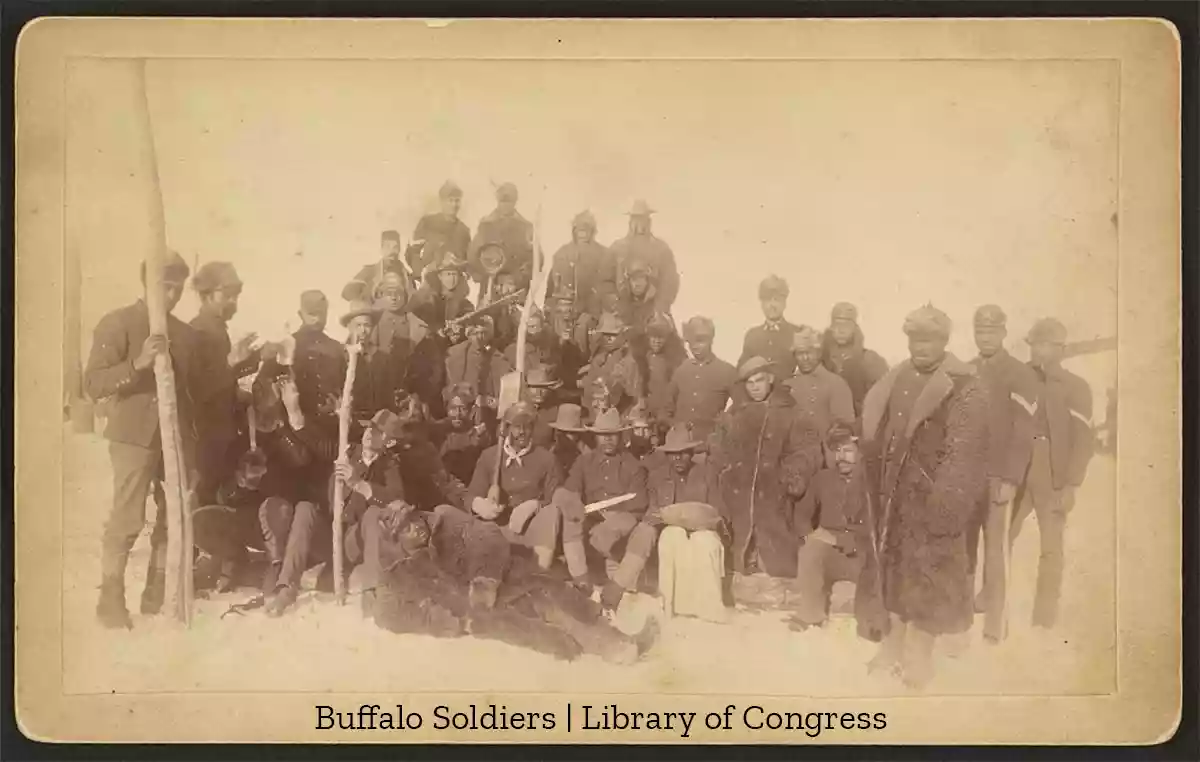
Buffalo Soldiers
Soldiers of the 9th and 10th Cavalry were more commonly known as the “Buffalo Soldiers”.
In 1866, the Congress of the United States authorized the formation of four all black regiments of the United States Army, respectively, the 9th and 10th Cavalry, and the 24 and 25 Infantry regiments. These all-black regiments were assigned white officers.
The formation of the 9th Cavalry took place in New Orleans, Louisiana, in September of 1866. The soldiers spent the winter organizing and training until they were ordered to San Antonio, Texas, in April 1867. There they were joined by most of their officers and their commanding officer, Colonel Edward Hatch.
The 10th Cavalry formed up at Fort Leavenworth Kansas in 1867, and placed under the overall command of Colonel Benjamin Grierson. These soldiers immediately began to establish a sense of security for Settlers and travelers headed to California and the Midwest across the Central Plains. The soldiers of all of these regiments, hoped to increase the respect and equality of treatment that had begun for black Americans during the Civil War and under the Emancipation Proclamation.
There is no definitive story behind why these soldiers received the nickname “Buffalo Soldiers”. One account alleges the nickname came from the soldiers’ dark, curly hair resembled the fur of a buffalo. Another account states that during an encounter with the Cherokee, the soldiers fought so valiantly and fiercely that the Indians revered their stamina and fighting prowess as they did the buffalo.
On April 18, 1875, companies A through F, K and M of the 9th Cavalry and companies A, D through G, I, and L of the 10th Cavalry were reassigned to frontier posts along the Texas Forts Trail, and headquartered out of Fort Concho Texas. Their mission during their Texas posting was to protect mail and travel routes, to control Indian movement in and out of reservations, provide protection from outlaws, and to map the unmapped portions of the western and northern Texas.
the 9th Cavalry was responsible for the success of the Cavalry campaign known as the Red River War against the Kiowas, the Comanches, the Cheyenne and the Arapahoe. It was after this three-month long battle that the 10th Cavalry arrived in Texas to assist.
Troops H and I of the 10th Cavalry made up part of the forces that rescued wounded Lieutenant-Colonel George Alexander Forsyth and his group of scouts who had been trapped on a sand bar and surrounded by Indians in the Arikaree River.
Not long after, the 10th Cavalry fought over two hundred Indians at Beaver Creek. These units received a field citation for gallantry from General Philip Sheridan. Soldiers of the 10th Cavalry accompanied General Sherman on his inspection tour of Indian depravations in Texas and they narrowly avoided attack by the same Kiowa and Comanche who were involved in the Warren Wagon Train Massacre.
By 1880, the 9th and 10th Cavalry Regiments had reduced Indian resistance in Texas and the 9th Cavalry was ordered to Indian Territory of Oklahoma. The 10th Cavalry fought to keep the Apache until the 1890s when they were reassigned to Montana to round up the Cree.
About 20 percent of U.S. Cavalry troops that participated in the Indian Wars were buffalo soldiers, who participated in at least 177 conflicts. The Buffalo Soldiers were responsible for stabilizing much of the Texas Frontier, as well as areas of Kansas, and New Mexico.

